This article needs additional citations for verification .(December 2009) |
The word bit is a colloquial expression referring to specific coins in various coinages throughout the world.
This article needs additional citations for verification .(December 2009) |
The word bit is a colloquial expression referring to specific coins in various coinages throughout the world.

In the US, the bit is equal to 12+1⁄2¢. In the U.S., the "bit" as a designation for money dates from the colonial period, when the most common unit of currency used was the Spanish dollar, also known as "piece of eight", which was worth 8 Spanish silver reales. $1⁄8 or 1 silver real was 1 "bit".
With the adoption of the decimal U.S. currency in 1794, there was no longer a U.S. coin worth $1⁄8, but "two bits" remained in the language with the meaning of $1⁄4. Because there was no 1-bit coin, a dime (10¢) was sometimes called a short bit and 15¢ a long bit. (The picayune, which was originally 1⁄2 real or 1⁄2 bit (6+1⁄4¢), was similarly transferred to the US nickel.)
In addition, Spanish coinage, like other foreign coins, continued to be widely used [1] and allowed as legal tender by Chapter XXII of the Act of April 10, 1806 [2] until the Coinage Act of 1857 discontinued the practice.
Robert Louis Stevenson describes his experience with bits in Across the Plains , (1892) p. 144: [3]
In the Pacific States they have made a bolder push for complexity, and settle their affairs by a coin that no longer exists – the bit, or old Mexican real. The supposed value of the bit is twelve and a half cents, eight to the dollar. When it comes to two bits, the quarter-dollar stands for the required amount. But how about an odd bit? The nearest coin to it is a dime, which is, short by a fifth. That, then, is called a short bit. If you have one, you lay it triumphantly down, and save two and a half cents. But if you have not, and lay down a quarter, the bar-keeper or shopman calmly tenders you a dime by way of change; and thus you have paid what is called a long bit, and lost two and a half cents, or even, by comparison with a short bit, five cents.
"Two bits" or "two bit" continues in general use as a colloquial expression, for 25¢, or a quarter dollar as in the song catchphrase "Shave and a Haircut, two bits." As an adjective, "two-bit" describes something cheap or unworthy.
Roger Miller's song "King of the Road" features the lines: Ah, but two hours of pushin' broom buys an / Eight by twelve four-bit room referring to signs stating "Rooms to let, 50¢."
In the early 1930s, Crown Records was a US record label which sold records for only 25¢. The company advertised on their sleeves, "2 Hits for 2 Bits."
Another example of this use of "bit" can be found in the poem "Six-Bits Blues" by Langston Hughes, which includes the following couplet: Gimme six bits' worth o'ticket / On a train that runs somewhere.…
The expression also survives in the sports cheer "Two bits, four bits, six bits, a dollar … all for (player's name), stand up and holler!"
The New York Stock Exchange continued to list stock prices in $1⁄8 until June 24, 1997, at which time it started listing in $1⁄16. It did not fully implement decimal listing until January 29, 2001.

From 1905 to 1917, the Danish West Indies used the bit as part of its currency system. In 1904, two new currency denominations were introduced: the bit and francs which were overlaid on the old cent and daler denominations. The four units were related as 5 bits = 1 cent, 100 bits = 20 cents = 1 franc, 100 cents = 5 francs = 1 daler. [4] Coins were issued each denominated in two units, bits and cents, francs and cents, or francs and daler. Postage stamps were denominated in bits and francs; the lowest value was five bits.
In Britain, Ireland and parts of the former British Empire, where before decimalisation a British-style currency of "pounds, shillings and pence" was in use, the word "bit" was applied colloquially to any of a range of low-denomination coins. [5] Thus a threepence coin or "threepenny piece" was referred to as a "threepenny bit", usually pronounced "thrupny bit".
The term was used only for coins with a value of several named units (e.g., three pence), and never applied to a penny, shilling, or half crown coin.
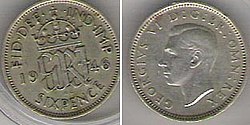
Although earlier there had been other values in circulation such as the "fourpenny bit" or "groat", the "bit" coins still in use in the United Kingdom up to decimalisation in 1971 were the two-shilling bit (or "florin") (often "two-bob bit"), the sixpenny bit (or "tanner"), and the threepenny bit.
In the UK, use of the term "bit" had already disappeared with the exception of the 'thruppeny bit', by the time British currency moved to decimal coinage and the consequential loss of the coin denominations to which it had applied. Thus a ten pence piece is referred to merely as "ten pence", or even "ten pee", not as a "tenpenny bit". The term 'pee' refers to the change in abbreviation of the British penny from 'd' to 'p' which denoted the 'New Penny'.
The historic American adjective "two-bit" (to describe something worthless or insignificant) has a British equivalent in "tuppenny-ha'penny" – literally, worth two and a half (old) pence.

The standard circulating coinage of the United Kingdom, British Crown Dependencies and British Overseas Territories is denominated in pennies and pounds sterling, and ranges in value from one penny sterling to two pounds. Since decimalisation, on 15 February 1971, the pound has been divided into 100 (new) pence. Before decimalisation, twelve pence made a shilling, and twenty shillings made a pound.

The shilling is a historical coin, and the name of a unit of modern currencies formerly used in the United Kingdom, Australia, New Zealand, other British Commonwealth countries and Ireland, where they were generally equivalent to 12 pence or one-twentieth of a pound before being phased out during the 1960s and 1970s.
Decimalisation or decimalization is the conversion of a system of currency or of weights and measures to units related by powers of 10.

Sterling is the currency of the United Kingdom and nine of its associated territories. The pound is the main unit of sterling, and the word "pound" is also used to refer to the British currency generally, often qualified in international contexts as the British pound or the pound sterling. In British English, its most common nickname is "quid".

The franc, also commonly distinguished as the French franc (FF), was a currency of France. Between 1360 and 1641, it was the name of coins worth 1 livre tournois and it remained in common parlance as a term for this amount of money. It was reintroduced in 1795. After two centuries of inflation, it was redenominated in 1960, with each new franc (NF) being worth 100 old francs. The NF designation was continued for a few years before the currency returned to being simply the franc. Many French residents, though, continued to quote prices of especially expensive items in terms of the old franc, up to and even after the introduction of the euro in 2002. The French franc was a commonly held international reserve currency of reference in the 19th and 20th centuries. Between 1998 and 2002, the conversion of francs to euros was carried out at a rate of 6.55957 francs to 1 euro.

Decimal Day in the United Kingdom and in Ireland was Monday 15 February 1971, the day on which each country decimalised its respective £sd currency of pounds, shillings, and pence.
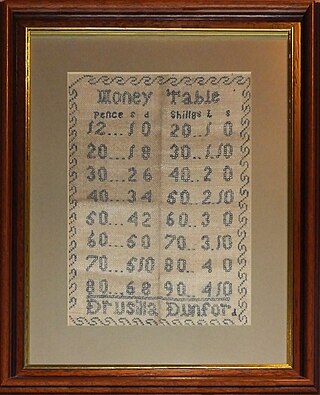
£sd, spoken as "pounds, shillings and pence", is the popular name for the pre-decimal currencies once common throughout Europe. The abbreviation originates from the Latin currency denominations librae, solidi, and denarii. In the United Kingdom, these were referred to as pounds, shillings, and pence.
The British West Indies dollar (BWI$) was the currency of British Guiana and the Eastern Caribbean territories of the British West Indies from 1949 to 1965, when it was largely replaced by the East Caribbean dollar, and was one of the currencies used in Jamaica from 1954 to 1964. The monetary policy of the currency was overseen by the British Caribbean Currency Board (BCCB). It was the official currency used by the West Indies Federation The British West Indies dollar was never used in British Honduras, the Cayman Islands, the Turks and Caicos Islands, the Bahamas, or Bermuda.

The pound was the currency of Australia from 1910 until 14 February 1966, when it was replaced by the Australian dollar. Like other £sd currencies, it was subdivided into 20 shillings, each of 12 pence.
The pound is the currency of Guernsey. Since 1921, Guernsey has been in currency union with the United Kingdom and the Guernsey pound is not a separate currency but is a local issue of sterling banknotes and coins, in a similar way to the banknotes issued in Scotland, England and Northern Ireland. It can be exchanged at par with other sterling coinage and notes.
Australian coins refers to the coins which are or were in use as Australian currency. During the early days of the colonies that formed Australia, foreign as well as British currency was used, but in 1910, a decade after federation, Australian coins were introduced. Australia used pounds, shillings and pence until 1966, when it adopted the decimal system with the Australian dollar divided into 100 cents. With the exception of the first Proclamation Coinage and the holey dollars, all Australian coins remain legal tender despite being withdrawn from circulation.

A non-decimal currency is a currency that has sub-units that are a non-decimal fraction of the main unit, i.e. the number of sub-units in a main unit is not a power of 10. Historically, most currencies were non-decimal, though today virtually all are now decimal.

The Jamaican dollar has been the currency of Jamaica since 1969. It is often abbreviated to J$, the J serving to distinguish it from other dollar-denominated currencies. It is divided into 100 cents, although cent denominations are no longer in use as of 2018. Goods and services may still be priced in cents, but cash transactions are now rounded to the nearest dollar.
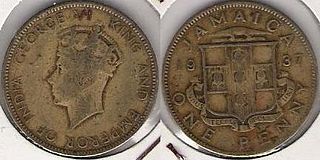
The pound was the official currency of Jamaica between 1840 and 1969. It circulated as a mixture of sterling coinage and locally issued coins and banknotes and was always equal to the pound sterling. The Jamaican pound was also used in the Cayman and Turks and Caicos Islands.
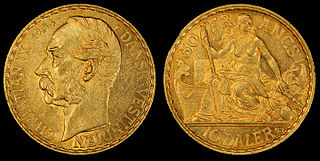
The daler was the currency of the Danish West Indies between 1849 and 1917, and of the United States Virgin Islands between 1917 and 1934.
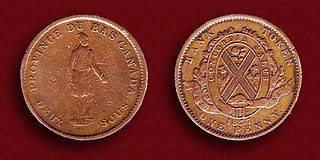
The pound was the currency of the Canadas until 1858. It was subdivided into 20 shillings (s), each of 12 pence (d). In Lower Canada, the sou was used, worth 1⁄2 penny. Although the £sd accounting system had its origins in sterling, the Canadian pound was never at par with sterling's pound.
The history of currency in the British colony of Dominica closely follows that of the British Eastern Caribbean territories in general. Even though Queen Anne's proclamation of 1704 brought the gold standard to the West Indies, silver pieces of eight continued to form a major portion of the circulating currency right into the latter half of the nineteenth century.
The history of currency in the British colony of Grenada closely follows that of the British Eastern Caribbean territories in general. Even though Queen Anne's proclamation of 1704 brought the gold standard to the West Indies, silver pieces of eight continued to form a major portion of the circulating currency right into the latter half of the nineteenth century.
The history of currency in the British colony of Saint Vincent closely follows that of the British Eastern Caribbean territories in general. As such, it should not be considered in isolation. In order to get a broad overview of currency in the region, see the article British West Indies dollar.
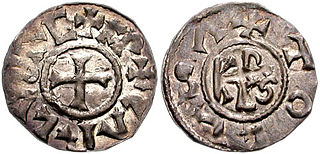
The Carolingian monetary system, also called the Carolingian coinage system or just the Carolingian system, was a currency structure introduced by Charlemagne in the late 8th century as part of a major reform, the effects of which subsequently dominated much of Europe, including Britain, for centuries. It is characterised by having three denominations with values in the ratio 240:12:1, the units of which went under different names in the different languages, but which corresponded to the Latin terms libra (pound), solidus (shilling) and denarius (penny), respectively.